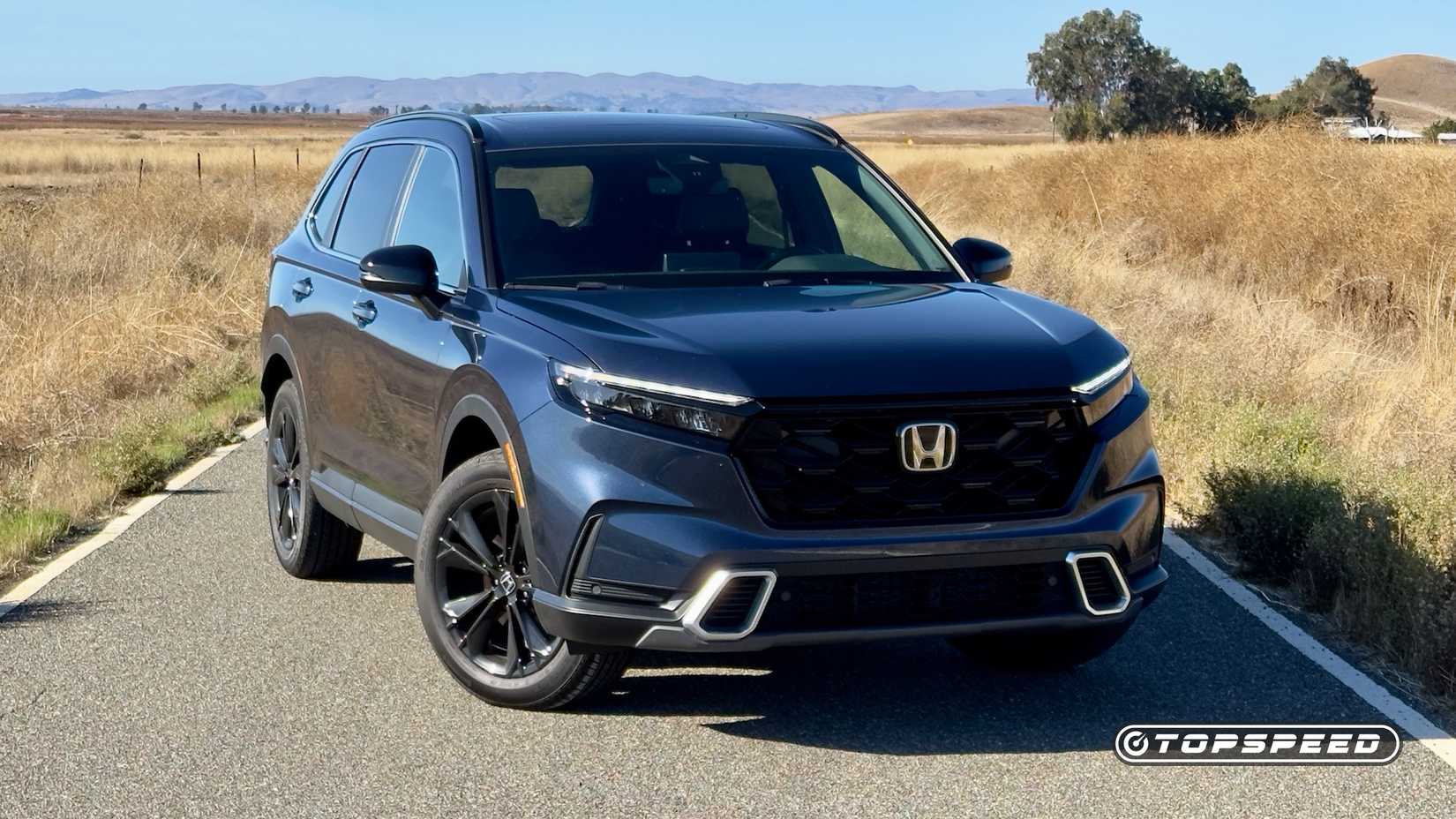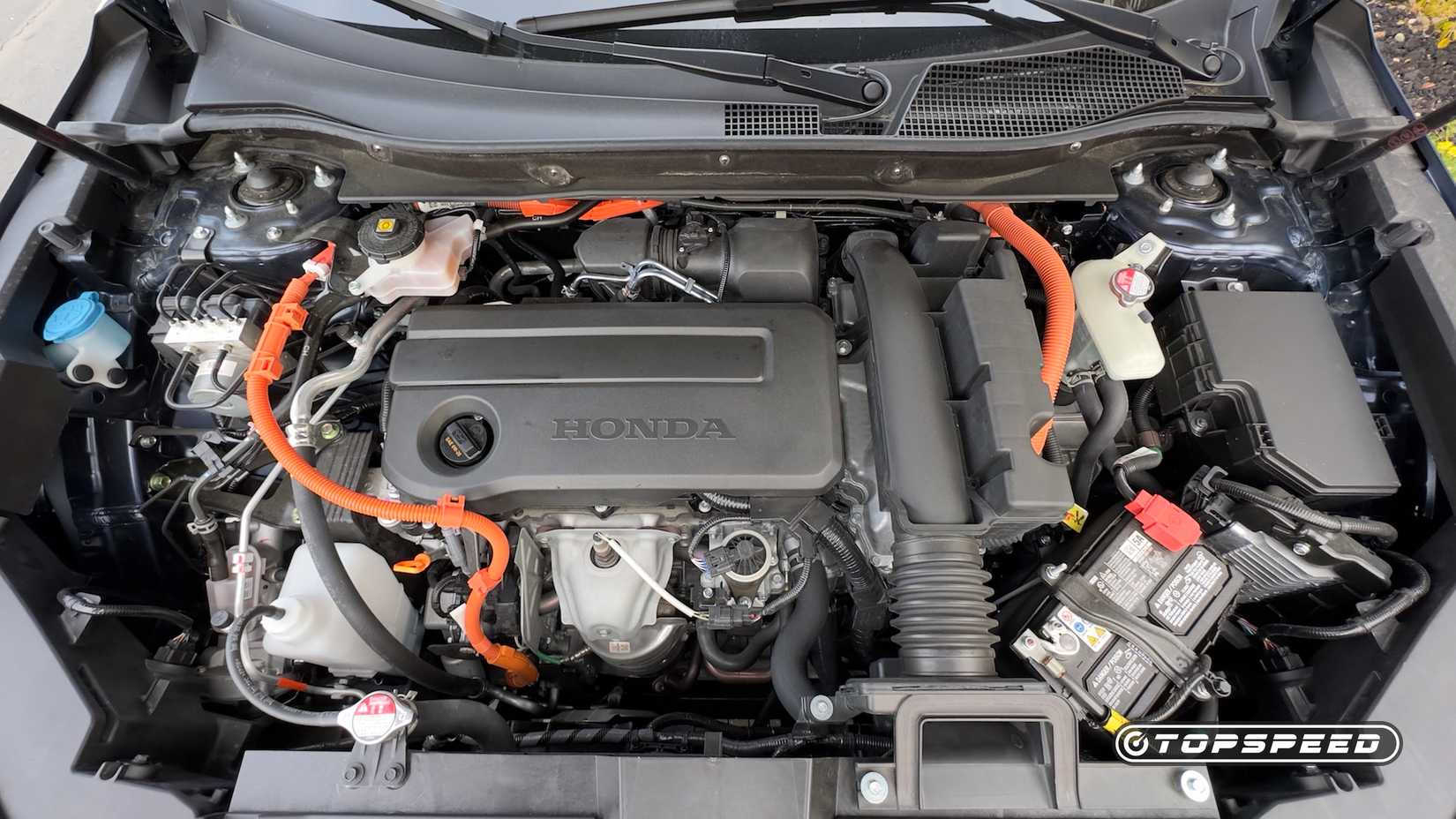As one of the founders of the compact SUV, the Toyota RAV4 has long stood as the benchmark by blending proven reliability, everyday usability, and strong efficiency. Its reputation has been built over years of consistent performance, dependable resale value, and an attractive balance of space and features. The hybrid joined the ranks with a mid-cycle refresh of the fourth generation in 2016, adding economy to the RAV4 skill-set.
-


- Base Trim Engine
-
Dynamic Force Hybrid
- Base Trim Transmission
-
CVT
- Base Trim Drivetrain
-
All-Wheel Drive
- Base Trim Horsepower
-
176 HP @5700 RPM
- Base Trim Torque
-
163 lb.-ft. @ 3600 RPM
- Base Trim Fuel Economy (city/highway/combined)
-
41/38/39 MPG
-


- Base Trim Engine
-
2.0L I4 Hybrid
- Base Trim Transmission
-
Electronic Continuously Variable Transmission (e-CVT)
- Base Trim Drivetrain
-
Front-Wheel Drive
- Base Trim Horsepower
-
204 hp
- Fuel Economy
-
43/36/40 mpg (FWD) | 40/34/37 mpg (AWD)
- Make
-
Honda
That reputation for excellence sets a high bar, and any competitor that dares to challenge it for public attention really needs to step up its game. Outpacing the Toyota RAV4 Hybrid, therefore, requires more than just an efficient powertrain—it demands sharper design, broader appeal, and a package that speaks to both practical needs and emotional connections. Through three-quarters of 2025, this particular hybrid SUV has managed to do just that through a systemic assault on various fronts.
To give you the most up-to-date and accurate information possible, the data used to compile this article was sourced from various manufacturers and other authoritative sources, including J.D. Power, GoodCarBadCar.net, and the EPA.
Reliability Remains A Selling Point For The Honda CR-V Hybrid
Owners Give High Scores In Reliability Surveys
The Honda CR-V has benefited from a long tradition of quality, with the model historically scoring high in the J.D. Power Quality & Reliability ratings, and markedly better than the Toyota RAV4 in the five years that the Honda CR-V Hybrid has been in existence. Honda CR-Vs have routinely earned high owner-survey scores in the low- to mid-80s (out of 100), while the RAV4 has consistently scored in the high-70s.
Over the first three quarters of 2025, Honda has estimated CR-V Hybrid sales of around 169,000. Honda doesn’t separate hybrid numbers from total CR-V numbers, but reports that hybrid sales typically account for 54–55 percent of total numbers, which tally 307,501 to date in 2025. Toyota sporadically reports RAV4 Hybrid numbers, and its latest report shows 2025 YTD Toyota RAV4 Hybrid numbers at 139,446, meaning the CR-V Hybrid is outpacing the RAV4 Hybrid by about 18 percent.
|
2025 CR-V Strengths |
2025 RAV4 Strengths |
|---|---|
|
|
Powertrain Differences
Higher Total Torque Means More Confidence
Though both Honda and Toyota use Atkinson cycle engines, the 2025 Honda CR-V Hybrid pairs a 2.0-liter four-cylinder with dual electric motors to deliver a stout 247 pound-feet of torque thanks to the electric motor’s instantaneous delivery. That torque number is significantly higher than the 2025 Toyota RAV4 Hybrid’s torque output (which Toyota doesn’t really elaborate on, beyond the engine’s 163 pound-feet, but Toyota Canada lists it at 221 pound-feet total).
In everyday driving, the Honda CR-V’s extra torque is especially welcome in city driving, where torque plays a bigger role than peak horsepower—the combined horsepower of the CR-V Hybrid is rated at 204, compared to the Toyota RAV4 Hybrid’s 219. The higher torque figure, delivered instantaneously by the electric motors, translates directly into stronger pull from stops, more confidence in merging, and better responsiveness under load or on uphills.
|
2025 CR-V Hybrid Strengths |
2025 RAV4 Hybrid Strengths |
|---|---|
|
|
Annual Fuel Costs
The EPA Pegs Average Yearly Fuel Costs At $1,150–$1,250
The 2025 Honda CR-V Hybrid carries an EPA combined fuel economy rating of 37–40 mpg (depending on drivetrain, which we will touch on later) under its hybrid powertrain. At current U.S. average fuel prices ($3.15 for unleaded regular), that translates into estimated annual fuel costs of between $1,150 and $1,250, which would mean estimated savings of between $2,250 and $2,750 over five years of ownership (compared to the average new vehicle driving 15,000 miles per year).
The 2025 Honda CR-V Hybrid is estimated to save about $50 in fuel compared to the 2025 Toyota RAV4 Hybrid. That’s only about a dollar per week, but it can add up to $250 over five years. It should be noted that the RAV4 has a slightly bigger fuel tank (14.5 gallons, versus the CR-V’s 14) and slightly more battery capacity (1.6 kWh versus 1.1, respectively), which accounts for the RAV4 Hybrid’s going longer on before needing to fill up (536–566 miles, versus 518–560).
|
2025 CR-V Hybrid Strengths |
2025 RAV4 Hybrid Strengths |
|---|---|
|
|
Ride And Handling Characteristics
Reviewers Praise Balance Of Power And Agility
Reviewers of the 2025 Honda CR-V Hybrid consistently praise its balance of comfort and agility, claiming the CR-V “retains normal handling characteristics despite an elevated ride height,” instilling confidence in corners without harshness. CarBuzz adds that the CR-V Hybrid’s AWD “ensures stable handling in all weather conditions.” Other media reviewers contrast the Toyota RAV4 Hybrid’s ride as more conservative—smooth, predictable, and tuned for comfort over engagement.
I found the 2024 Honda CR-V Hybrid Sport Touring AWD is nimble enough to be interesting, while also providing generous measures of quiet, smoothness, and refinement.
– Lyndon Conrad Bell, TopSpeed Journalist
The 2025 Honda CR-V Hybrid is consistently praised as leaning more toward “fun without the drama,” which is sometimes associated with fun, whereas the RAV4 Hybrid “offers a smoother, more predictable driving experience” that comes with composed neutrality. The CR-V’s chassis tuning lets drivers feel confident in transitions and mid-corner adjustments; the RAV4 Hybrid prioritizes a wash of calm over feedback. Buyers seeking a touch more engagement will “connect” better with the CR-V.
|
2025 CR-V Hybrid Strengths |
2025 RAV4 Hybrid Strengths |
|---|---|
|
|
Standard Safety Features
More Comprehensive Suite Of Driving-Aid And Safety Technologies
The 2025 Honda CR-V Hybrid comes standard with the Honda Sensing suite of safety and driving-assist technology, including Collision Mitigation Braking (CMBS), Adaptive Cruise Control with Low-Speed Follow, Lane Keeping Assist, Road Departure Mitigation, Lane Departure Warning, Traffic Sign Recognition, and Forward Collision Warning. The suite complements core systems like Vehicle Stability Assist (VSA) with traction control, ABS, and a full complement of airbags.
The 2025 Toyota RAV4 Hybrid counters with its Toyota Safety Sense 2.5 suite, which bundles many of the same safety features—automatic emergency braking, pedestrian detection, adaptive cruise, lane-tracing assist, among others—though the nomenclature is different. Differences between the two emerge in the optional packaging of features like blind-spot monitoring and rear cross-traffic alert, which Toyota offers as options or standard at higher trim levels.
|
2025 CR-V Hybrid Strengths |
2025 RAV4 Hybrid Strengths |
|---|---|
|
|
Seating Room Makes A Difference
Front Seats Offer More Head, Shoulder, Hip, And Leg Room
The 2025 Honda CR-V Hybrid offers a well-thought-out interior for passengers, with 103.5 cubic feet of passenger volume in a 106 cubic-foot interior. The front seats offer 38.2 inches of headroom, 57.9 inches of shoulder room, 55.6 inches of hip room, and 41.3 inches of legroom. For comparison, the 2025 Toyota RAV4 Hybrid offers up 37.7 inches of headroom, 57.8 inches of shoulder room, 54.3 inches of hip room, and 41.0 inches of legroom in its 98.9 cubic-foot passenger space.
By contrast, the 2025 Toyota RAV4 Hybrid may offer a better balance between front and rear seats, with 39.5 inches of rear headroom (over an inch greater than that of the CR-V Hybrid’s 38.2), and it also tops the Honda in shoulder-to-shoulder seating (56.4 inches vs. the CR-V’s 55.9). The CR-V Hybrid cushion room is better at three-abreast (52.6 inches of hip room versus the Toyota’s 47.7) and seat slide-ability over 81 inches of legroom (front + rear), compared to the RAV4’s 78.8.
|
2025 CR-V Hybrid Strengths |
2025 RAV4 Hybrid Strengths |
|---|---|
|
|
The CR-V’s Cargo Space Is Well Thought-Out
More Cargo Room Overall And Better Versatility
Belying its smoothly contoured exterior shell, the 2025 Honda CR-V Hybrid offers impressive cargo room and versatility for a compact crossover. With the rear seats folded, it opens up 76.5 cubic feet for cargo, which eclipses the 2025 Toyota RAV4 Hybrid’s 69.8. With the rear seats in use, the CR-V offers between 34.7 and 36.3 cubic feet of trunk space (the Sport Touring has a trunk-mounted subwoofer that takes up a cubic foot and a half). Both are still smaller than the RAV4 Hybrid’s 37.5 cubic feet.
The cargo-space advantage isn’t just about cubic-foot numbers — the 2025 Honda CR-V Hybrid’s shape and packaging tend to make loading easier, and the flatter floor tends to make it more usable. The RAV4 Hybrid’s cargo space is very good with the rear seats in use, but once the seats go down, it’s not as cargo-friendly, and bigger items or a full cargo load are a tighter fit.
|
2025 CR-V Hybrid Strengths |
2025 RAV4 Hybrid Strengths |
|---|---|
|
|
Drivetrain Choice Offers More Customization
FWD Models Offer Purchase And Ownership Savings
Unlike the 2025 Toyota RAV4 Hybrid, buyers of the 2025 Honda CR-V Hybrid have the option of both front-wheel and all-wheel drivetrains (depending on trim level). Lower- and mid-level Sport trims are available in FWD, while the top TrailSport and Sport Touring Hybrids come standard with AWD. The main benefit of choosing FWD over AWD is better fuel economy, thanks to fewer moving parts and lower weight.
All 2025 Toyota RAV4 Hybrids come standard with AWD, which means that every hybrid RAV4 carries the weight, complexity, and fuel implications of an AWD system (somewhat offsetting the gains of the wonderful Toyota hybrid system). In addition to savings at the pump with the FWD CR-V Hybrid, fewer moving mechanicals also mean potentially lower maintenance costs and savings at the time of purchase. If you’re going to restrict your CR-V Hybrid to city driving, FWD can save a lot of cash.
|
2025 CR-V Hybrid Strengths |
2025 RAV4 Hybrid Strengths |
|---|---|
|
|
Convenience Features
More Standard “Nice Things” To Have
The 2025 Honda CR-V Hybrid comes well-equipped with the “nice to have” convenience features, many of which are either standard or more widely available. For example, carpeted floor mats are standard on all CR-V Hybrid trims, but added-on costs on all Toyota RAV4 Hybrid trims, while a power moonroof is a standard CR-V Hybrid fitment, but not available on some RAV4 Hybrids. Heated front seats are also standard, while RAV4’s are part of a package.
The 2025 Toyota RAV4 Hybrid does offer a wealth of solid convenience features, and its upper trim levels are loaded with features such as panorama and power moonroof, dual-zone climate control, height-adjustable rear hatch, and smart key/push button start. However, many convenience features are not standard on base or mid-trims, not available on lower trims, or often require paying extra. For similar starting MSRPs, the CR-V Hybrid avoids the “nickel-and-diming” buyers loathe from dealerships.
|
2025 CR-V Hybrid Strengths |
2025 RAV4 Hybrid Strengths |
|---|---|
|
|
Bang For The Buck
Offers More Standards, Cargo Space And Versatility, And More Value
When you look at the complete picture, the 2025 Honda CR-V Hybrid makes a strong case for itself as a better value buy compared to the 2025 Toyota RAV4 Hybrid. When you add up the tick marks for MSRPs, the broader inclusion of standard features, and the balance of passenger and cargo space usability, it’s clear Honda has built a compact hybrid SUV that’s easier to justify in the showroom, with option bundles for buyers who are willing to pay for more.
The 2025 Toyota RAV4 Hybrid is by no means a slouch or a bad deal. Its powertrain, performance, and cabin comfort and versatility are impeccable, but it seems to segregate many of its value-added features to let customers choose the trim level they are most comfortable with, and then add on from there. The sales momentum is apparently on Honda’s side through 2025, and it’s clear that shoppers are rewarding the CR-V Hybrid for its smart packaging and genuine consumer-focused appeal.
Source: EPA, J.D. Power



















